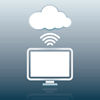The IoT Revolution Dips into the Internet of Water
A team of scientists is tapping electronics distributors and open source data to create better, cheaper environmental monitoring stations — and they want to help others do it themselves.
Our water resources are under constant assault. Agricultural runoff, chemical pollutants, pharmaceuticals, water-borne pathogens, and other factors can render water unsafe to drink or swim in, take fish off the table, and impact the health of surrounding ecosystems. Water can harbor diseases such as Legionaire’s, which killed 12 people in Flint, Michigan, and cholera, which emerged after recent flooding in the Indian state of Kerala. Algae blooms can make inland lakes unsafe for swimmer and anglers. As the East Coast of the US begins to clean up after Hurricane Florence, scientists are closely monitoring water resources to make sure overflow from open pits of coal ash and pig manure don’t contaminate drinking water.

Sensors run from this compact monitoring station outfitted with a Mayfly data logger to a water monitoring well in a wetland.
For years, corporations and government entities have used “black box” water monitoring stations to continually evaluate water conditions and transmit data back to a control center. However, the base cost for the logger station portion of these devices starts at $5,000 and they have limitations that present problems to repair and maintain for many users. Now a group of scientists has devised a better, cheaper device that utilizes off-the-shelf electronics components and the Internet of Things (IoT) to collect and transmit water data. The brains of their monitoring stations is called the Mayfly Data Logger and they’ll sell you one — but they’d rather teach you to make one yourself.
Anthony Aufdenkampe, then a researcher at the Stroud Water Research Center in Pennsylvania, spotted an article in Wired magazine called “The New Industrial Revolution” that described how open-source, Arduino-framework electronics were making it possible for anyone with a good idea to execute technical projects using off-the-shelf electronics and open-source plans. Inspired, his group designed a water-monitoring station using open source plans they found online. The team included an electrical engineer, Shannon Hicks, who was already dabbling with Arduino framework electronics. “She soon had electronics boards that were about the size of a credit card logging from many of the brand name water and soil sensors,” said Beth Fisher, who was working with the team on a National Science Foundation watershed project that became one of the first installation sites.
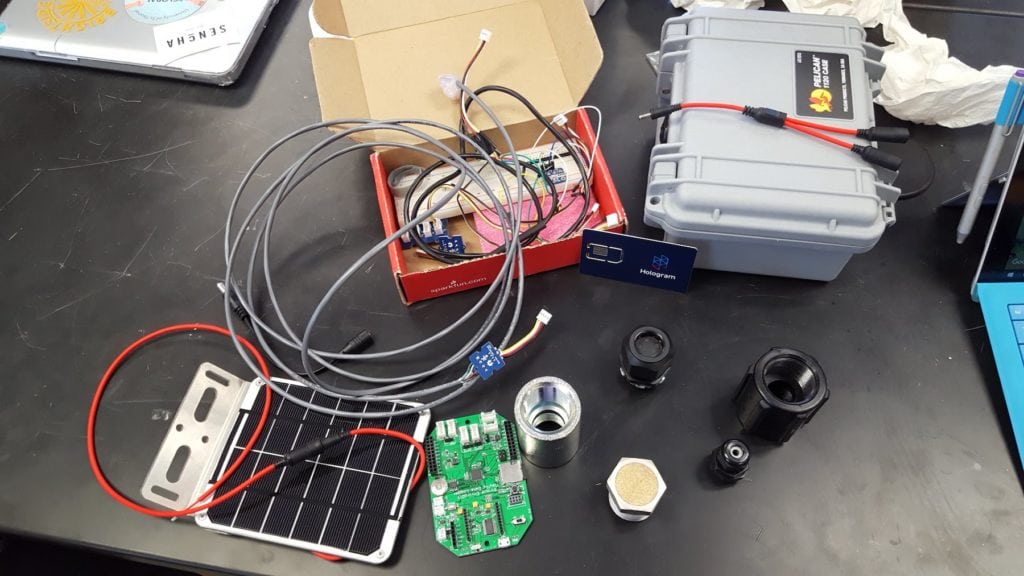
Waterproof Pelican boxes are modified to house electronics in a weather-resistant package.
Aufdenkampe and Hicks continued to innovate their design, adding solar-charging data loggers and devising a waterproof package, ultimately settling on a simple, waterproof Pelican case with submersible cord grips to make a weatherproof electronic enclosure. They sourced components from Digi-Key Electronics, Mouser, Adafruit, SparkFun, Voltaic Systems, and other companies to assemble monitoring stations with a base cost of less than $400. When the microprocessor boards they were using as data loggers were discontinued, Hicks created the Mayfly, a custom Arduino-framework logger that beats the big black boxes by every measure. “This logger enables us to lower the cost of monitoring hardware by thousands of dollars with no sacrifice in data quality.”

“Our stations are half the size of a shoebox, including small solar panels, whereas the commercial stations are often the size of a dog house,” Aufdenkampe said. “We can monitor a wide variety of things, including conductivity, dissolved oxygen, pH, blue-green algae, turbidity, chlorophyll, water depth, and temperature. The logger can coordinate with manufactured devices that sample water into barrels or even bottles at timed intervals during a storm event, which can then be taken to a lab for chemical analysis.”
The stations include a microSD card for storage, and the Mayfly can stream data to internet repositories such as data.EnviroDIY.org because it has an XBee wireless communication socket. In addition to water sensors, the pictured station has an atmospheric sensor that measures pressure, temperature, and humidity. A JST 2-pin connector links power to a solar battery charger and radio transmitter. A micro-USB is used for programming and communication and it activates the battery charging relay. Hicks selected Grove connectors and ports for sensor connections for their ease of use and modular design.
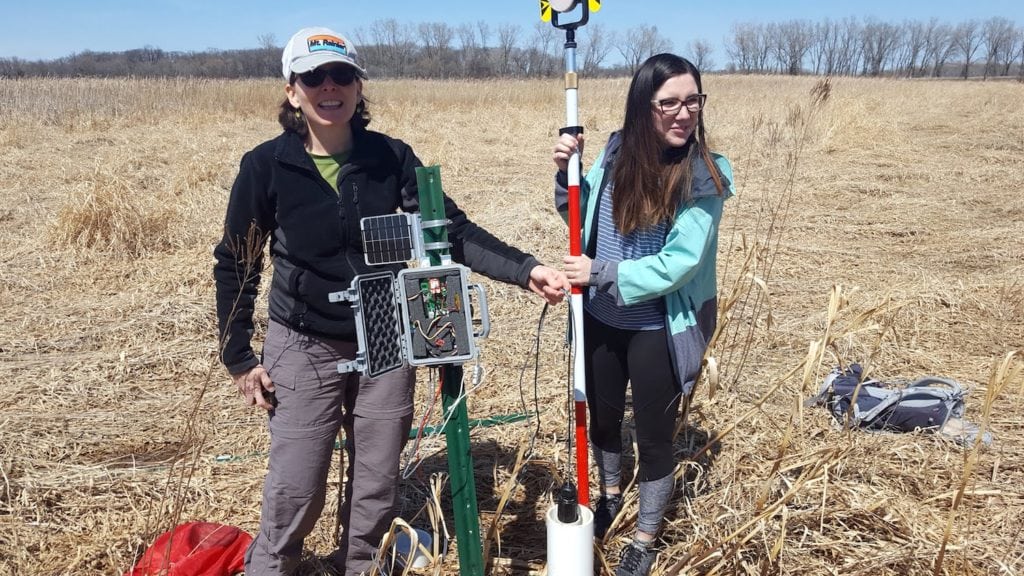
Beth Fisher and University of St. Thomas student Courtney Pelissero install a groundwater monitoring station in a wetland. The project is part of an effort to reduce nitrate and phosphorus inputs to the Sunrise and St. Croix River in the Midwestern US.
The three have built hundreds of stations, and these more affordable devices are helping an expanded network of individuals and entities collect data on water resources across the US and as far away as Bhutan, where they are used by the National Center for Hydrology and Meteorology. “They are helping scientists, researchers, teachers, and even private citizens who want to monitor the moisture of their house plants or the water quality of the lake at their cottage,” said Fisher, now a researcher at University of Minnesota. Aufdenkampe is now a Senior Environmental Scientist for the water resources firm, LimnoTech.
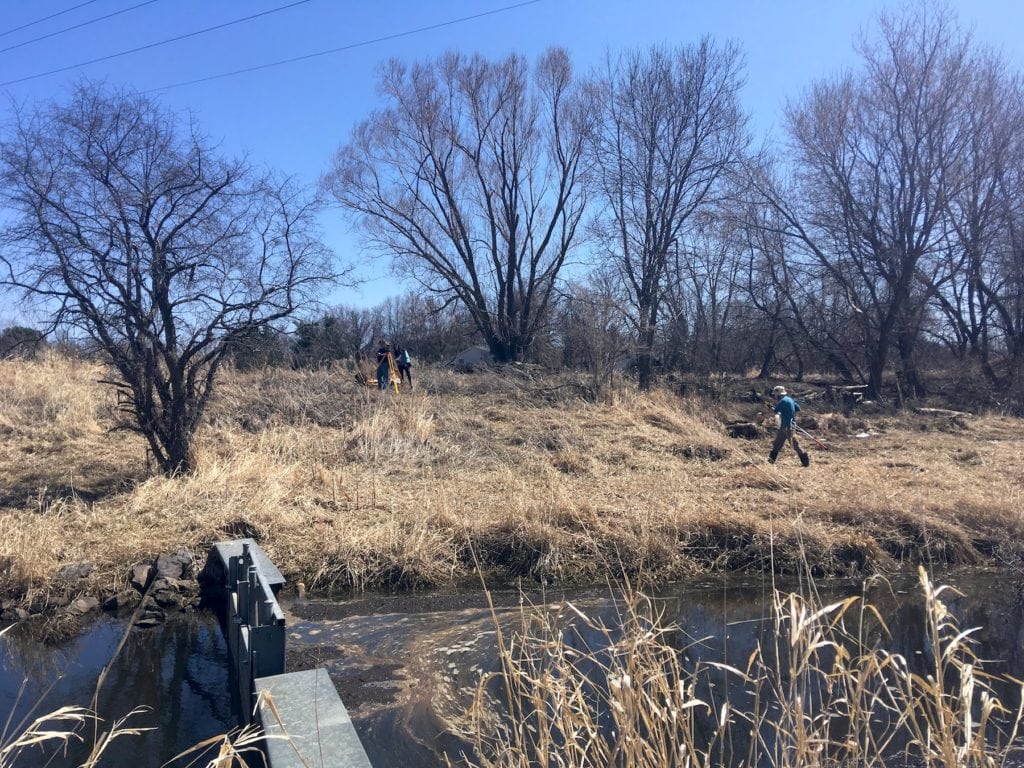
The monitoring station enables the scientists to better characterize precipitation, runoff, and shallow groundwater processes. That data will provide a deeper understanding of the efficacy of the wetland in mitigating water movement and contaminants.
“Ordering the parts for each station is a time-consuming process because we order off-the-shelf components from several vendors and we assemble them ourselves by drilling holes in Pelican cases, tapping them, and screwing in water-tight submersible cord grips,” said Aufdenkampe. The end product is a powerful, user-programmable water quality monitoring station that is fully compatible with the Arduino IDE software. “We have to solder many of the components, and you really have to understand quite a bit about the electronics and the programming of the stations to make it all work.”
As that Wired article promised, anyone can make one. Fisher wants to train more people to build, maintain and use the stations, because the technology offers so much potential to science. But she admits that it can be a challenging project for scientists with limited electronics experience.
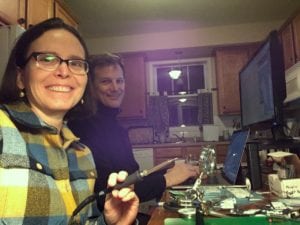
This is how you DIY: Fisher and Aufdenkampe solder parts for a water monitoring station.
“DIYers generally find rapid success at reading data from simple sensors to an Arduino board,” said Fisher. “However, it is much more challenging for beginners to program an Arduino to perform all required functions of a solar-powered station that collects data from several research-grade environmental sensors, saves to an SD card, transmits to a public server with web services, and puts the sensors to sleep to conserve energy between logging intervals.” Stroud Water Research Center programmer Sara Geleskie Damiano created a Modular Sensor Library that allows users to choose from several common water monitoring sensors from a bundled program that has all of the functions needed for environmental monitoring.
Since the project was made possible by open source information sharing, the group is committed to making it possible for others to replicate their design and navigate the complexities involved in bringing it to its full potential. The open source ethos mirrors their commitment as scientists to helping people gather data that can be used to improve and protect resources. While he was at Stroud, Aufdenkampe’s team founded sharing platform EnviroDIY to expand high-tech knowledge sharing in the environmental sciences.
“Sharing what we learn is really important to the open-source community. We keep track of our work in GitHub repositories. We also contribute blog posts and forum responses to the scientific community,” said Aufdenkampe, who has made all of the code and most of the hardware plans available for free. “Smart Water and the Internet of Water are still in their infancy, but the IoT revolution has great potential to transform water quality monitoring.”
Learn more at EnviroDIY.
Interested in a specific market? Click a market below for current articles and news.
Automotive, Consumer, Industrial, Medical, Mil/Aero, Datacom/Telecom, and Transportation
- Where in the World is Amphenol LTW’s Luc Kan? - April 23, 2024
- TE Connectivity’s Sustainability Efforts Pay Off - April 23, 2024
- What is a VGA Connector? - April 23, 2024





